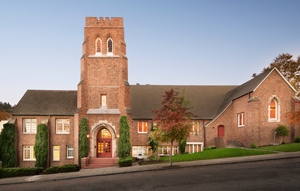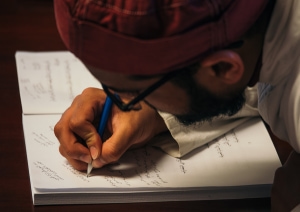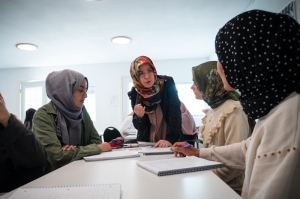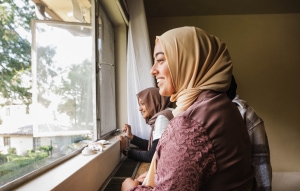Beyond Black and White: The Art of Calligraphy
Calligrapher Elinor Aishah Holland does not believe in black and white. “The only absolute is God,” she says. “Everything else is relative.” Perhaps that’s why she likes to experiment with different shades of ink: because the landscape of our lives is nuanced and colorful.
As a guest lecturer, Ustadha Aishah will add a fine arts component to Zaytuna’s 2024 Summer Arabic Intensive. She’ll introduce undergraduates to Islamic calligraphy through the rika style of Arabic script — a simple, elegant, and readable form. For Zaytuna’s broader community, she will also offer two sessions of Letter by Letter: Practicing Calligraphy, a two-day workshop suitable for students of all levels. And she will offer a free public lecture, The Path of the Pen, on campus in July. (Click here for more information.)
Holland prized pen and paper from a very early age. Then, when she visited Istanbul as a teenager, she discovered and fell in love with Arabic script calligraphy. She later received her ijaza, or diploma, in two forms of classical Arabic script from Master Calligrapher Mohamed Zakariya. Now married to her art form for more than forty years, she exhibits, teaches, and does commercial and commissioned work. Her clients include The Smithsonian Institute, The New York Public Library, and the Metropolitan Museum of Art. She has exhibited her work throughout the United States as well as in Kuwait, The United Arab Emirates, Saudi Arabia, and Algeria.
Calligraphy is a precise art form that Aisha teaches with a playful spirit. Holding a pen aloft on the first day of class, she tells her students: I will help you learn how to play this instrument — but first you must forget everything you thought you knew about a pen and an alphabet. She asks them to hold their mysterious new instrument gently, and to view letters as abstract forms. Her intention is to make calligraphy accessible to students of all levels.
In spite of her impressive credentials, Ustadha Aishah would like to demystify what she calls “the lettering life.” Students who fall in love with calligraphy, like she once did, should know it takes a great deal of time and patience to earn an ijaza. (It took Aishah more than twenty years to earn hers as she was raising her children and earning a living.) Her experience proves that slow, steady progress can lead to extraordinary outcomes.
A calligrapher’s journey, she points out, is not a race to the finish line. Cultivating a practice is at least as important as earning a diploma. Practicing calligraphy, she says, is like daily prayer: sometimes transcendent, sometimes mundane. It is a practice of focusing and slowing down, and it can be physically exhausting. Over time, a steady commitment cultivates patience and discipline, and deepens one’s relationship to beauty, stillness, and solitude.
Aishah wonders if that’s why she feels such a kinship with other calligraphers. Is it their love of ink and paper? Their lifelong devotion to patience and focus? Their obsession with letters and endless striving for perfection? She’s not sure. All she knows is that in her experience, belonging in a calligraphy community has been a great reward of choosing this path.
Asked if she considers her art form a spiritual practice, Aishah shrugs her shoulders. “Aren’t we supposed to remember God in everything we do?” she replies with a smile. Still, she can’t deny the moments when something sacred flows through her body onto paper. At its best, the practice of calligraphy becomes an embodied way to engage with sacred text, to create harmony, and to witness something holy coming into the world through her pen.
Krista Bremer is a writer at Zaytuna College.



